Subscriber Benefit
As a subscriber you can listen to articles at work, in the car, or while you work out. Subscribe Now For years, it has been accepted as near-gospel that the basketball court in Hinkle Fieldhouse is the original, as old as the legendary building itself—93 years, to be exact. That’s what many university officials have believed, what people taking tours of the building have been told, and what many former players have assumed to be true.
For years, it has been accepted as near-gospel that the basketball court in Hinkle Fieldhouse is the original, as old as the legendary building itself—93 years, to be exact. That’s what many university officials have believed, what people taking tours of the building have been told, and what many former players have assumed to be true.
Bring up the subject to none other than Bobby Plump, who hit a legendary shot on it to win a state championship for Milan in 1954, and he exclaims without hesitation, “I know it is!”
Breaking news: It isn’t. Don’t blame Plump or anyone else for what they have been led to believe, however, because it comes down to a virtual quibble. The floor happens to be not quite original, installed late in 1932 rather than early in 1928. That matters hardly at all, because it’s still regarded as the oldest floor in use in the country among high school, college and professional teams, and stands as an architectural wonder all its own.
Storied history
Imagine an 89-year-old basketball floor, used continually—other than a break during World War II—by the host school, Butler University, but also sporadically by high schools, NBA and WNBA franchises, and all-star teams from all levels of the game.
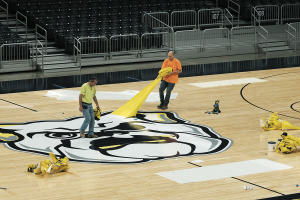
Imagine, then, all the great players who have tread on its varnished surface. At least 70 members of the Naismith Hall of Fame can be verified as having played or coached on the fieldhouse floor, and that no doubt leaves out several administrators, referees and other Hall members who have encountered it during visits to the fieldhouse.
Clearly, it’s a floor with a high ceiling for historic merit, having provided a sneaker-squeaking platform for an unprecedented and diverse array of legendary players and coaches. Such as:
◗ Johnny Wooden, a member of the Indianapolis Kautskys professional team in the 1930s and coach of the UCLA team that played at Butler in 1962.
◗ NBA stars such as George Mikan, Bob Cousy, Slater Martin and Jim Pollard, who were opponents of the Indianapolis Olympians in the early 1950s.
◗ Bobby “Slick” Leonard, as a sophomore and senior at Indiana University.
◗ Oscar Robertson, star of the Attucks teams that won state championships in 1955 and 1956 and again with the Indiana All-Star team as Mr. Basketball in 1956.
◗ John Havlicek and Jerry Lucas, sophomores on the Ohio State team that played at Butler in the 1959-1960 season. Bob Knight played in that game as well, and the first IU team he coached played there in 1971.
◗ Roger Brown, Mel Daniels and Connie Hawkins, in the ABA’s first all-star game in 1968. Rick Barry, a commentator on the television broadcast, walked the hardwood after the game when he helped present the Most Valuable Player trophy to Larry Brown.
◗ Pete Maravich, in the East-West College All-Star game in 1968, in which he was voted Most Valuable Player.
◗ Artis Gilmore, as a member of a U.S. team that played a Russian team in 1971.
◗ Larry Bird, as an Indiana All-Star in 1974 and a member of Indiana State’s team in 1977.
◗ Ann Meyers, during the Pacers’ training camp in 1980 while becoming the only woman to try out for an NBA team.
◗ Reggie Miller and Chris Mullin, when the Pacers conducted a practice there amid the playoffs in 1998.
◗ Tamika Catchings, with the Indiana Fever in a preseason WNBA game in 2004.
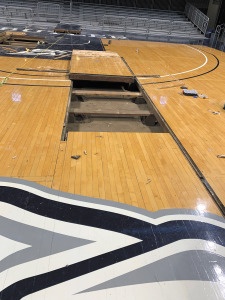
Countless other notable players, including college All-Americans, Indiana Mr. Basketballs, and members of sectional, regional, semistate and state finals teams from 1933 to 1971 have taken turns on the floor as well, all sharing a memorable experience.
Ask around and the veterans of Hinkle’s maple gem agree that it’s not just old, it is superior. It doesn’t rest just a few inches off a concrete floor as most portable courts do. It is raised 10 inches, with a complex support system that allows it to have some give. That, in turn, provides some spring for the players as they run and jump.
Hallie Bryant played on it in the state tournament with Attucks and as Indiana’s Mr. Basketball in 1953, then again with IU. He went on to play all over the world as a Globetrotter.
“It was unforgettable,” he says. “It was my favorite court of all courts in the world.”
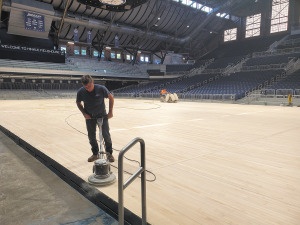
Plump, who played throughout the United States, Mexico and the Middle East following his career at Butler, has a similar view.
“It had more give than any court I played on,” he says. “You never got shin splints. You could feel it in your shoes when you dribbled the ball. Oscar [Robertson] would say the same thing. So would George.”
George would be McGinnis, who won a state championship with Washington High School on the court in 1969 and played on it again as Mr. Basketball and then as a member of an all-star team that played a Russian contingent in 1971.
“That floor had bounce in it,” he says. “There were a few dead spots, but it was an incredible floor to play on. I think everybody I know feels the same way about it.”
That group would include Bill Keller, who, like McGinnis, led Washington to a state championship on the court in 1965 and as Mr. Basketball.
“It was easy to run on, easy to play on,” he says. “If you’re going to play two games in one day [as was done on Saturdays throughout the state tournament], that’s the court to play on.”
Matt Howard, a member of Butler’s NCAA tournament finalist teams in 2010 and 2011, wasn’t aware of the court’s history and doesn’t have particular memories of it. But given the chance to ponder, he wonders if the court kept players healthier.
“I don’t remember us ever having any kind of serious injury on that court,” he says. “Maybe that correlates. Some things are fluke, but I would like to think a floor like that would provide less impact or landing injuries.”
A new direction
The playing floor ran east-west when the fieldhouse opened in 1928 but was switched to a north-south configuration just ahead of the 1932-1933 season. That adjustment enabled the addition of bleachers that increased the seating capacity and lessened the likelihood of shooters having to contend with sunlight streaming through the windows into their eyes during day games.
Some articles and photo captions of that time referred to the floor as having been “turned around” heading into the 1932-1933 season, creating an impression it was not replaced. An article in the Sept. 30, 1932, edition of the student newspaper, The Butler Collegian, was more precise, however. It began:
“Purchase of a new portable playing floor for the fieldhouse and a new set of portable bleachers is to be made in the near future according to President Walter Scott Athearn, who is conferring with other university officials concerning the selection of equipment for the school.”
A later Collegian article reported:
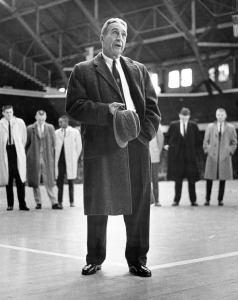
“Work on the new basketball floor in the fieldhouse was started last week when a crew of workers began preparing the foundation base. Five hundred cement blocks will form the foundation of the new floor which will be one of the best in the state, Coach Tony Hinkle said.”
Butler records indicate the Indiana High School Athletic Association had proposed paying for the bleachers if the university covered the cost of the court. The manufacturer is unknown, and the cost uncertain.
Regardless, a new floor was a major expenditure during the Great Depression, particularly one of exceptional quality. Money was so tight at the time that the university dropped the price of adult tickets for basketball games from $1 to 40 cents for the 1932-1933 season. Children 12 and under were admitted for 25 cents. Other state schools made similar reductions to enable fans to attend games.
Sally Wirthwein, a Butler alum and Hinkle Fieldhouse historian, said the university also had been put on a one-year probation by the North Central Association, which provides accreditation for colleges, for having placed too much emphasis on athletics. The university responded by purchasing more library books and endowments. That would seem an unlikely time to be purchasing a basketball court. Perhaps the original floor was poorly constructed and had to be replaced after just 4-1/2 seasons.
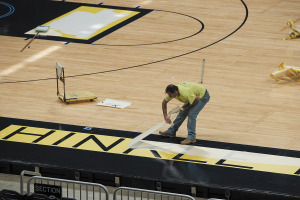
Whatever the reason and whatever the cost, the floor has proved to be a savvy investment. Hinkle sold it short when he predicted it would be one of the best in the state. It’s clearly one of the best in the world. History aside, its bones are superior, with thicker boards for the playing surface and the support system underneath. The support boards are 1-1/4-inch thick, as would be used for a deck, rather than a half-inch as with some modern courts.
“You just don’t see this anymore,” said Chris Pierle, Butler’s fieldhouse crew supervisor of internal operations. “It was from a time when a 2-by-4 was a 2-by-4, not an inch-and-a-half by 3 inches.”
It appears to have plenty of years left, too. Barry Collier inquired about its life expectancy when he took over as Butler’s athletic director in 2006 and was told 40-60 years. Pierle said it will last “beyond our lifetime.”
Unlike any other
It doesn’t just happen, though. It recently was sanded and refinished, a process performed about every 10 years, and some support boards were replaced. It is lightly sanded and recoated every summer. It helps that, although a portable court, it has been allowed to rest in peace on a permanent basis for the better part of the past 75 years. It was dismantled for the Butler Relays, a national indoor track meet, from 1933 through 1942 and for other events in the 1930s and was stored at the Fairgrounds during World War II when the fieldhouse was used as a barracks. It has been dismantled only on rare occasions since then, such as for Sonja Henie’s ice show in 1952, but it has mostly sat unperturbed. None of Butler’s current administrators have a memory of its being removed.
Collier said nobody was allowed to play on it during the off-season when he was a member of Butler’s team from 1974-1976, a policy he changed when he became head coach in 1989. It is covered for graduation ceremonies and other university events and another portable court was placed on top of it when NCAA tournament games were played there in March.
Only a few college basketball facilities are older than Hinkle, but all have playing floors far younger than 89 years. Far newer arenas have replaced floors as well. Consider that Purdue’s Mackey Arena opened in 1967, and its court was replaced in 2011—largely because of water damage. IU’s Assembly Hall opened in 1971, and its portable court was replaced in 1995. Bankers Life Fieldhouse opened in 1999, and its portable court is replaced every 10 years.
Even the court in Hinkle’s auxiliary facility, the Efroymson Family Gym, installed in 1928, has been replaced twice, most recently in 2019. “And it really needed it,” Collier said.
The fieldhouse court just carries on, collecting history along the way.•
__________
Montieth, an Indianapolis native, is a longtime newspaper reporter and freelance writer. He is the author of three books: “Passion Play: Coach Gene Keady and the Purdue Boilermakers,” “Reborn: The Pacers and the Return of Pro Basketball to Indianapolis,” and “Extra Innings: My Life in Baseball,” with former Indianapolis Indians president Max Schumacher.
Please enable JavaScript to view this content.

One of the best venues in all of sports.